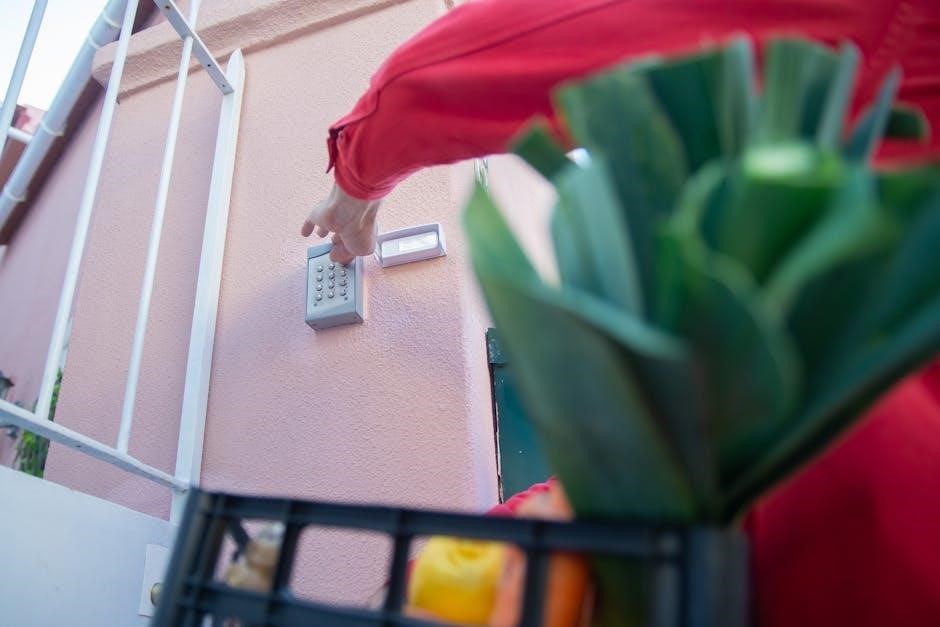
The Honeywell Security Pad Manual serves as a comprehensive guide for understanding and operating Honeywell security systems‚ offering detailed instructions for setup‚ operation‚ and troubleshooting.
1.1 Overview of Honeywell Security Systems
Honeywell Security Systems provide reliable and advanced solutions for home and business protection. Known for their robust features‚ these systems include keypads‚ sensors‚ and panels designed to ensure maximum security. Models like the 6160 and 6150 offer customizable options‚ encryption‚ and compatibility with various devices. They cater to diverse needs‚ from basic access control to comprehensive security management‚ ensuring adaptability and reliability for users worldwide.
1.2 Importance of the Honeywell Security Pad Manual
The Honeywell Security Pad Manual is essential for users to maximize their system’s functionality. It provides clear instructions for installation‚ operation‚ and troubleshooting‚ ensuring optimal performance. With detailed guidance on arming‚ disarming‚ and customizing settings‚ the manual empowers users to configure their security systems effectively‚ enhancing safety and efficiency for both residential and commercial applications.

Installation and Setup Guide
This section provides a step-by-step guide for installing and configuring the Honeywell Security Pad‚ ensuring a smooth and secure setup process for optimal functionality and performance.
2.1 Hardware Installation Steps
Begin by unboxing and preparing the Honeywell Security Pad. Mount the keypad securely on the wall or place it on a flat surface. Connect the necessary wires to the control panel‚ ensuring compatibility with Honeywell devices. Follow the user manual for specific wiring instructions. Power on the system and test functionality. Ensure all connections are secure and properly configured for reliable performance and integration with other security components.
2.2 Software Configuration Process
Access the Honeywell Security Pad manual for software setup instructions. Enter Installer mode using the default code or your assigned credentials. Configure system settings‚ including security codes‚ zone definitions‚ and communication parameters. Save changes and exit Installer mode. Test the system to ensure proper functionality. Refer to the manual for detailed guidance on advanced configurations and troubleshooting common issues during setup.
Understanding Key Features of the Honeywell Security Pad
The Honeywell Security Pad offers a user-friendly interface with a backlit display‚ customizable buttons‚ and advanced security features‚ ensuring enhanced control and monitoring of your system.
3.1 Types of Displays Available
Honeywell Security Pads feature various display options‚ including the 6160RF’s 32-character alpha display for detailed status updates and the 6150RF’s fixed display for zone information. The wireless 5839 keypad offers a basic status display‚ while higher models include backlit screens for enhanced visibility‚ ensuring users can monitor their security system effectively in any lighting condition.
3.2 Functions of Each Button on the Keypad
The Honeywell Security Pad’s keypad features buttons with specific functions‚ such as arming/disarming‚ zone bypassing‚ and emergency responses. The [1]‚ [OFF]‚ [*]‚ and [#] buttons simplify navigation‚ while the alpha display models offer advanced command inputs. The manual details each button’s role‚ ensuring users can customize their security settings efficiently and respond to system alerts promptly. This design enhances user experience and system control.
Arming and Disarming the Security System
To arm your Honeywell Security System‚ enter your security code to activate the desired mode‚ such as home or away. Disarm by re-entering your code within the grace period upon entry. Emergency disarming involves quickly entering your code or pressing specific buttons to stop alarms. Familiarize yourself with keypad buttons for functions like zone bypassing. Check for status indicators like lights or sounds to confirm arming or disarming. Troubleshoot issues by resetting or checking the power supply. Practice these steps for comfort and security.
4.1 Step-by-Step Arming Process
To arm the system‚ ensure all zones are secure. Enter your security code using the keypad. Select the desired mode (Stay or Away) by pressing the corresponding button. Verify that all zones are closed and no issues are displayed. The system will confirm arming with LED indicators or sounds. If prompted‚ press “OK” to proceed. The keypad will display “System Armed” once the process is complete.
4.2 Detailed Disarming Procedure
To disarm the system‚ enter your security code on the keypad. Press “OK” or the designated disarm button. Check the display for any alarms or issues. If prompted‚ acknowledge alarms by pressing the corresponding buttons. The system will confirm disarm with LED indicators or sounds. Ensure all zones are disarmed and no errors are displayed. The keypad will show “System Disarmed” once complete.

Troubleshooting Common Issues
Identify keypad display problems‚ system malfunctions‚ or connectivity issues. Refer to error codes and reset procedures in the manual for quick resolution. Ensure proper device compatibility.
5.1 Resolving Keypad Display Problems
Check connections and power supply to ensure proper functionality. Clean the display screen to remove dirt or debris. Restart the system to resolve software glitches. If issues persist‚ consult the manual for reset procedures or contact Honeywell support for assistance.
5.2 Addressing System Malfunctions
Identify the root cause of malfunctions‚ such as power issues or faulty sensors. Check connections and ensure the system is powered on. Restart the system to resolve temporary glitches. Refer to the manual for troubleshooting guides. If unresolved‚ contact Honeywell support for professional assistance to restore functionality and ensure system reliability.

Security Modes and Configurations
Honeywell Security Pad offers multiple modes‚ including High Security Mode‚ to enhance system protection. Configure settings for encryption and compatibility to ensure optimal performance and robust security.
6.1 Enabling High Security Mode
Honeywell Security Pad’s High Security Mode enhances system protection by restricting functionality to encrypted devices. To enable‚ enter your code and select the mode. This ensures advanced security but may limit compatibility with non-encrypted devices. Disabling it allows both encrypted and non-encrypted commands‚ offering flexibility at a slightly reduced security level.
6.2 Understanding Encryption and Device Compatibility
Honeywell Security Pad systems use encryption to secure data transmission between devices. High Security Mode requires encrypted devices to ensure data integrity and prevent unauthorized access. Compatibility is crucial‚ as non-encrypted devices may not function in this mode. Always verify device compatibility before enabling encryption to maintain seamless system operation and robust security.
System Compatibility and Integration
Honeywell Security Pad systems are designed to integrate seamlessly with various devices and security features‚ ensuring enhanced functionality and robust protection. Compatibility with systems like Vista-20P and Lyric‚ as well as wireless keypads‚ allows for a unified security solution. This integration ensures optimal performance and scalability‚ catering to diverse security needs while maintaining reliability and ease of use.
7.1 Compatible Devices and Systems
Honeywell Security Pad systems are compatible with a wide range of devices‚ including the 6160RF keypad‚ Vista-20P‚ and Lyric systems. They also integrate seamlessly with wireless keypads like the 5839 and 6150 models. Additionally‚ these systems work alongside encryption-enabled devices‚ ensuring secure communication. Compatibility with various security features‚ such as smoke detectors and motion sensors‚ enhances overall system functionality and provides a comprehensive security solution.
7.2 Integration with Other Security Features
The Honeywell Security Pad seamlessly integrates with various security components‚ including wireless keypads‚ Vista series panels‚ and Lyric systems. It also works with motion sensors‚ smoke detectors‚ and video cameras‚ ensuring a unified security ecosystem. This integration allows for enhanced functionality‚ such as remote arming/disarming and real-time alerts‚ while supporting smart home automation features for a comprehensive security solution.

Advanced Features and Customization
The Honeywell Security Pad offers advanced customization options‚ including custom user management‚ scene programming‚ and event triggers‚ allowing tailored security configurations for enhanced system personalization and control.
8.1 Customizable Security Configurations
The Honeywell Security Pad allows users to create tailored security setups‚ enabling personalized configurations such as custom user codes‚ arming delays‚ and zone-specific responses. Advanced features include scene programming and event-driven actions‚ which enhance system adaptability. Users can define unique settings for different scenarios‚ ensuring a balance between convenience and robust security. This flexibility empowers users to adapt the system to their specific needs‚ improving overall safety and efficiency.
8.2 Access Control and User Management
Honeywell Security Pad offers robust access control and user management features‚ allowing system administrators to create and manage multiple user profiles. Each user can be assigned unique access codes‚ permissions‚ and privileges‚ ensuring that only authorized individuals can arm or disarm specific zones. Additionally‚ the system supports temporary access codes for visitors and contractors‚ enhancing security while maintaining convenience. Logs of user activities provide transparency and accountability.

User Manuals and Additional Resources
Official Honeywell manuals provide detailed guidance for security systems‚ including setup‚ operation‚ and troubleshooting. Additional resources like online support and user guides are also available.
9.1 Accessing Official Honeywell Manuals
9.2 Online Support and Guides

Maintenance and Firmware Updates
10.1 Regular Maintenance Tips
10.2 Updating Firmware for Optimal Performance
The Honeywell Security Pad Manual provides comprehensive guidance for optimal system performance. Regular updates and proper maintenance ensure long-term reliability and security effectively.
11.1 Best Practices for Using the Honeywell Security Pad
Regularly update your system and maintain strong passcodes. Train all users on keypad functions to ensure smooth operation. Monitor activity logs and address alarms promptly. Keep the keypad clean and check for firmware updates. Test the system periodically to ensure reliability. Familiarize yourself with troubleshooting steps to resolve common issues quickly. Always follow the manual’s guidance for optimal security performance.
11.2 Ensuring Long-Term Reliability and Security
Regularly check for firmware updates and maintain a stable power supply. Ensure all users follow security protocols and update passcodes periodically. Keep the keypad clean and avoid exposure to extreme conditions. Monitor system activity and address potential vulnerabilities promptly. Always follow Honeywell’s guidelines for optimal performance and security. This ensures your system remains reliable and secure over time.